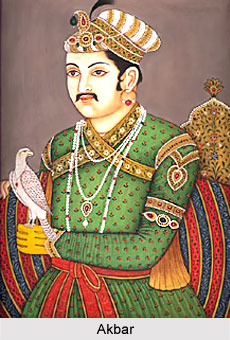 Rajput policy of Akbar was based on a planned policy towards the Rajputs. Akbar was the first Mughal emperor who pursued such a policy. Akbar was an imperialist and desired to bring under his rule as much territory of India as was possible. Therefore it was necessary to bring the Rajput rulers under his suzerainty. Akbar preferred to befriend the Rajputs instead of turning them into his enemies. He was impressed by the chivalry, faithfulness, fighting skill, etc. of the Rajputs. Akbar wanted dependable allies from among the Indian people instead of depending on foreigners. The Rajputs, therefore, became a good choice. The liberal religious policy of Akbar also directed him to be friendly with them. Akbar thus tried to befriend the Rajputs but at the same time desired to bring them under his suzerainty.
Rajput policy of Akbar was based on a planned policy towards the Rajputs. Akbar was the first Mughal emperor who pursued such a policy. Akbar was an imperialist and desired to bring under his rule as much territory of India as was possible. Therefore it was necessary to bring the Rajput rulers under his suzerainty. Akbar preferred to befriend the Rajputs instead of turning them into his enemies. He was impressed by the chivalry, faithfulness, fighting skill, etc. of the Rajputs. Akbar wanted dependable allies from among the Indian people instead of depending on foreigners. The Rajputs, therefore, became a good choice. The liberal religious policy of Akbar also directed him to be friendly with them. Akbar thus tried to befriend the Rajputs but at the same time desired to bring them under his suzerainty.
Akbar captured strong forts of the Rajputs like the forts of Chittor, Ranthambhor, and Kalinjar. This weakened the power of the Rajputs to offer him resistance. Those Rajputs rulers either accepted his sovereignty or entered into matrimonial relations with him. They were left masters of their kingdoms and were given high offices in the state and there was no interference in their administration. They were, however, asked to pay annual tribute to the emperor. Those Rajput rulers, who opposed him, were attacked and efforts were made to force them to accept his sovereignty. The case of Mewar is the best example of it. Among the rulers who voluntarily accepted the sovereignty of Akbar was Raja Bharmal of Ajmer. He met Akbar in 1562 A.D., accepted his sovereignty and married his daughter to him. This very princess gave birth to prince Salim.  Akbar gave high mansabs to Raja Bharmal, his son, Bhagwan Das and his grandson, Man Singh. After the fall of the fort of Chittor a few Rajput states like Bikaner and Jaisalmer voluntarily accepted the suzerainty of Akbar, while some of them entered into matrimonial alliances with him. After the battle of Haldi-Ghati a few more Rajput rulers like that of Banswara, Bundi and Orcha also accepted the suzerainty of Akbar. Thus, most of the Rajput rulers submitted to Akbar without fighting, entered into his service, became his loyal allies-and a few among them became his relatives as well.
Akbar gave high mansabs to Raja Bharmal, his son, Bhagwan Das and his grandson, Man Singh. After the fall of the fort of Chittor a few Rajput states like Bikaner and Jaisalmer voluntarily accepted the suzerainty of Akbar, while some of them entered into matrimonial alliances with him. After the battle of Haldi-Ghati a few more Rajput rulers like that of Banswara, Bundi and Orcha also accepted the suzerainty of Akbar. Thus, most of the Rajput rulers submitted to Akbar without fighting, entered into his service, became his loyal allies-and a few among them became his relatives as well.
The Rajput policy of Akbar was a grand success. All Rajput states, except Mewar, accepted the sovereignty of Akbar. Those very Rajputs who were fighting against the Muslim rulers for the last three hundred fifty years submitted to Akbar and participated in the expansion of the Mughal Empire. Akbar was the real founder of the Empire of the Mughals and the first successful conqueror of Rajput independence. Due to the Rajput policy of Akbar, the Rajputs forgot their ideal of maintaining their independent political existence and they gladly pulled up their strength with the Mughal emperor. It was the greatest success of Akbar. It helped in expanding and strengthening the Mughal Empire. Akbar neither forced any Rajput ruler to enter into matrimonial alliance with him nor asked their princesses to accept Islam before marrying them. Besides, he honoured his wives, allowed them to follow their own religion, respected their Rajput relatives and gave them high offices in the state.
The Rajputs became loyal supporters of the Mughal emperor because Akbar offered most liberal terms to them in exchange of their services and friendship to him. Akbar simply desired that the Rajputs should accept his sovereignty, pay him annual tribute, surrender their foreign policy to him, support him with their forces when necessary and regard themselves as one with the Mughal Empire. In return, Akbar was prepared to give them liberty in their internal matters, honour them, offer them services in the state according to their merit and provide them complete religious freedom. The liberality of Akbar was the primary reason of the success of his Rajput policy.






































